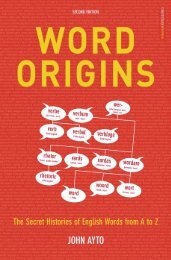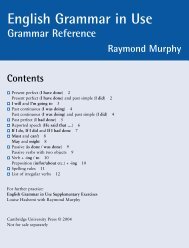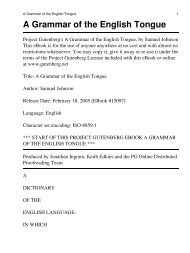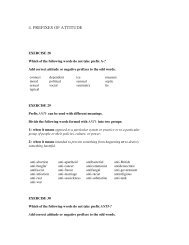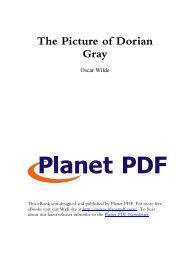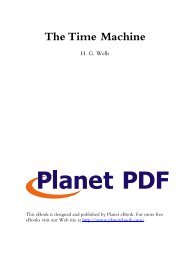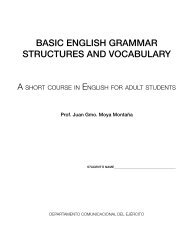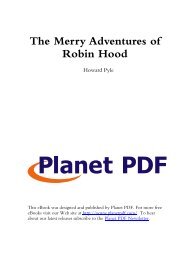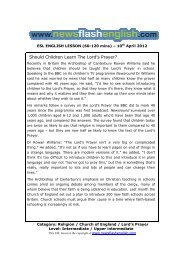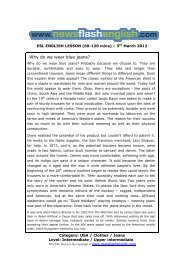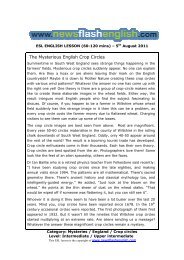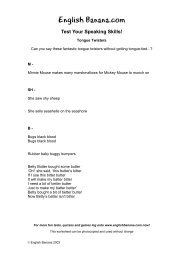TO DOWNLOAD - 75 Pages (928kb - PDF format) - ESL Teachers ...
TO DOWNLOAD - 75 Pages (928kb - PDF format) - ESL Teachers ...
TO DOWNLOAD - 75 Pages (928kb - PDF format) - ESL Teachers ...
Create successful ePaper yourself
Turn your PDF publications into a flip-book with our unique Google optimized e-Paper software.
RHE<strong>TO</strong>RICAL SKILLS23 STRATEGY/WRITINGSTRATEGIESOnce you as a writer complete a paragraph or essay, andhave carefully proofread your work, you still need togive it one more overall evaluation. You must make sureyou have selected the most logical transitions betweenparagraphs, and have used language that is appropriatefor the intended audience. You should check whether ornot you have added enough supporting material to adequatelycomplete each paragraph, and whether or notevery sentence or paragraph is relevant to the selection.A good way to prepare for a final review is to becomefamiliar with basic writing strategies and some of theprinciples that apply to each.23A DescriptionDescriptive writing usually relies on sense impressionsrecordsof what the eye sees, the ear hears, the nosesmells, the tongue tastes, and the skin feels. If you arecontemplating how a descriptive selection can bestrengthened, be sure to consider the addition of morespecific sense impressions.In addition to sense impressions, descriptive writingoften employs a dominant impression at the outset of theselection, a controlling idea that helps unify the passageand place the specific details employed.Smith was a great bear of a man, and, when hestooped through the frame of a door, he virtuallyfilled the opening. Once he made it through andstood at his full height again, he sort of reared up,exactly like a bear facing an intruder. Nor was hemuch more friendly. Framed by matted, curly redhair, his wide face communicated a perpetualscowl, intensified by large, stark, wide-set blueeyes that expressed unrelenting outrage at whatthey saw. Beneath the eyes, high, weatheredcheekbones gave his face its Slavic expanse, andhis large flat nose was misshapen by decades ofbar brawls. His vast, red handlebar mustacheaccented the large twisted lips that expressed grimdispleasure; ancTbeneafh, his huge chin stuck outlike a bartering ram.23B NarrationNarration is usually a series of events presented inchronological sequence, all of which have one purpose:to tell what happened. Narration, primarily used in storytelling,biographical histories, diaries, and journals, is afundamental strategy in all writing. To be effective, narrationrequires coherent order and also a good deal ofrich, descriptive detail.Any discussion of the structure of me narrative passagefocuses on the order of events that make up the narrative.The exact chronological relationships among the eventsare signaled by tenses, transitions, and time markers.Notice how the author of the following selection useseach of these cues to establish coherent order.In the past, this type of literature—whether inbooks or magazines—was published under suchtitles as Travel Adventures, Wonder Stories,Fantastic Tales or Mysteries of the Universe, it tookgarish "headlines" like these to draw attention tothe special nature of this material.In 1929, Hugo Gernsback, a New York magazinepublisher ana one of the great pioneers in the Fieldwe are exploring here, provided the much-neededcommon denominator by coining the inspired termscience fiction.Instantly and universally, science fiction wasdefined and accepted as a form of literaturedistinct and apart from all others, a form thatimposed on the writer none of the shackles thatconfine traditional writing to the limits of so manyrules and precedents.Comfortably settled under the aegis of its brandnewgeneric name, science fiction prospered inspite of a worldwide depression and World WarII. Other entertainment media contributed theirshare. The movies gave us Boris Karloff asFrankenstein's monster and Fredric March as Dr.Jekyll. In 1938, a science fiction radio programabout Martian invaders threw the East Coast of theUnited States into a panic.Note that the events in the development of science fictionare carefully presented in a clear, coherent sequence andinclude cues that leave no doubt about the order in whichthese events took place. For instance, the use of in thepast this type of literature , . . was published in the firstparagraph establishes the fact that science fiction existedin some form before the events described in the subsequentparagraphs. In the next three paragraphs, such transitionsand time markers as in 1929, instantly anduniversally, comfortably settled,..under...brandnew...name,worldwide depression, World War II, and in1938 firmly establish the relative order of events.23C Explanation of a processExplaining a process is, in some ways, similar to narration;however, you have to be even more careful with thesequence of events. Narration adheres in general to asequence; a process depends exactly on a sequence, onethat can be repeated time after time with the same results.In explaining a process, the use of transitional signalssuch as after, before, next, immediately, while the [glue]is still (wet], and when [this] is done, to indicate thesequence of steps, is an essential writing strategy. Toevaluate the sequence of steps in a process passage, paycareful attention to transitional words and phrases.23D Classification and divisionClassification helps organize detailed material into differentgroups so that it can be dealt with in steps orstages, can be seen more clearly, or can be explained orillustrated in all its diversity.Suppose that you are a newspaper writer who specializesin communicable diseases and that you want to do an arti-36



